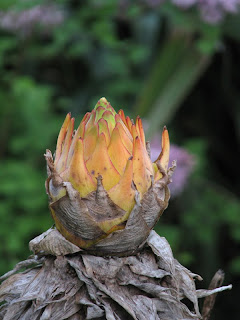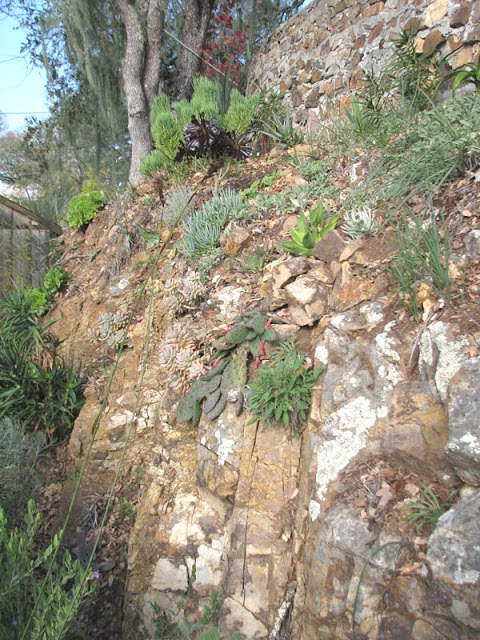
Four golden lotus "flowers" in May as new leaves are just starting to emerge in my Calistoga garden.
I first heard of Musella in the mid-90's in some catalogue (can't remember the name) which mentioned its great hardiness and showed a tiny picture of its "flower". At that time I was living and gardening at the Maybeck Cottage Garden in Berkeley CA, and I was open to trying almost anything. I also like the look of bananas and had several growing in the garden there already. (The name Musella is a diminuative of Musa, a genus of bananas). Soon afterward, I noticed Heronswood Nursery (then in Kingston WA) had it listed in their catalogue, and since at that time I was ordering dozens of fascinating plants from that amazing place (quite different from today), I ordered one. I have to confess I also loved the name, Musella, so soothing and mellifluous.
In the winter months after the leaves die off, a swollen "bud" emerges from the succulent trunk.
I planted my new treasure in the front bed, where the breakfast nook jutted out, and enjoyed its tropical looking foliage the first season. Even in its first year the main stem became surrounded by many pups. In the second season, the plant grew robustly developing a thick succulent short trunk from which 4' long elongated oval leaves were produced. By this time the plant was a small colony of stems and leaves and provided a lovely contrast to the chusan palm, Trachycarpus wagnerianus, nearby. But it was still entirely a foliage plant. It wasn't until the third winter that it finally flowered.
Here in my Calistoga garden, Musella forms an excellent mass of large foliage that is highly resistant to tearing or shredding - so common in true bananas. The large foliage, while textural in itself, provides a "shadow board" for the nearby Trachycarpus.
First season "bud" on left and second season "bud" on right. Initially this "flower" will seem to come out of the stem top, whereas in subsequent years it will appear on top of the dried bracts of the previous seasons' "flower". Eventually the entire stem will die.
From my experience both in Berkeley and Calistoga, this budding can occur nearly any winter month, but is inevitable by spring. As the outer bracts of this "bud" curl back, an interior of dozens of golden bracts condensed into a fat artichoke-like structure is revealed . These continue to curl back, eventually forming the "lotus-like" head that is strangely beautiful with its cone-like center with a glowing tip, and golden orange reflexed bracts.

Three true flowers can be seen poking out of the base of the bracts as they reflex.
The "true" flowers are actually small tubular flowers on the inside base of each bract. They are the same color as the bracts, and are partially hidden unless you look directly inside the head. They are extremely popular with hummingbirds in my garden suggesting that there is a reward inside each tube. The humming birds will often sit on the reflexed bracts and delicately sip out of the rows of tubular flowers. For some reason this sight always reminds me of a comparative wine tasting.
The color(s) of the "lotus" have a wonderful radiant quality, even during dreary wet weather, the glowing heads almost appear to float in the landscape, reinforcing the appropriateness of its common name. On those days with glowing skies at sunset or dawn, the heads almost seem on fire.
Two close ups of the foliage showing the pronounced textural quality of the leaves which are slightly folded with a strong central rib running the length and a herring-bone pattern of the lateral veins - more pronounced below than above.
The color(s) of the "lotus" have a wonderful radiant quality, even during dreary wet weather, the glowing heads almost appear to float in the landscape, reinforcing the appropriateness of its common name. On those days with glowing skies at sunset or dawn, the heads almost seem on fire.
A second season "flower" showing both the lovely spiral arrangement of the bracts and the glowing golden color that seem radiant in early or late light.
This closer view of the Musella foliage shows the rippled leaf surface, adding a pleasant visual richness to the leaf. The ability for shadows to play on the leaf is another plus.
Gradually, as spring moves into summer, the leaves will once again re-appear and gradually "swallow up" the golden louts heads, masking them unless you have the curiosity to pry apart the leaves. But from my observations it seems like the flowering stops altogether. And while the floral heads are what may attract the plant enthusiast, the foliage mass is not to be disparaged. In many ways it is most similar to the bird-of paradise plant, Strelitzia reginae, but with bigger bolder leaves, more like the giant bird-of-paradise, S. nicolai, but not quite as large and never developing the tall trunk that species will develop. The biggest plus is that the leaves are very tough, seldom ripping or shredding which is so common on the big Strelitzia and most bananas. My biggest plant in the Calistoga garden gets the full brunt of near-hurricane force winds during our many ferocious wind storms - storms that often last more than a day. These are storms that can defoliate some plants - but not the Musella. Not that these leaves are completely tear proof, but they are tough.
By the second season after flowering, the flower head and stem finishes its life cycle. On the left the smaller head is above the previous season's dried bracts. On the right, flowering has ceased and large, pea-sized black seeds burst out of their enclosures.
While I have read that this plant grows best with routine water and good drainage, and I'm sure the plant would love these conditions, my reality has been of heavy soils and drought stress. Yet my plants look great. And better than that, the foliage shows almost no stress even on the hottest days - often in the low hundreds (F) here, while almost everything else in the garden looks wilted and distressed. I think the fleshy root mass probably accounts for this ability to deal with so much heat, providing water even when there isn't any in the surrounding soil.
A garden view of Musella in May on a rainy day where the flower heads suggest torches.
Fortunately for us here in the Bay Area of CA, this once obscure plant is no longer hard to find in the retail nursery trade. So for those who have a tickling for the tropical, let us lotus, the golden lotus that is.
Whether in sun or overcast, the plant in f lower is radiant; a wonderful addition to any garden.






















